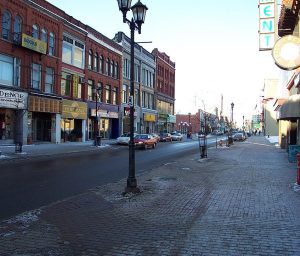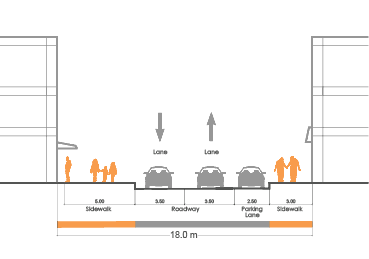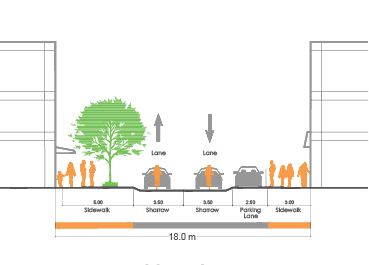Kitchener is a mid-sized city in the Regional Municipality of Waterloo, Ontario, located west of Toronto. In 2019, the City of Kitchener approved Complete Streets Kitchener: Streets for All. TCAT provided a peer review of these Complete Street guidelines which played a role in Council approval.
Kitchener
On October 28, 2019, the City of Kitchener approved Complete Streets Kitchener: Streets for All. The staff report of the Complete Streets guidelines and appendices are here and minutes are found here. TCAT provided a peer review of the guidelines which played a role in Council approval.
In addition to approving the Complete Streets guidelines, Kitchener City Council also passed the following motions:
- The Guidelines are to be applied to the design of future street reconstruction projects.
- The Complete Streets scorecard will be incorporated into street reconstruction project planning and reporting.
- Staff are directed to update the city’s Development Manual to incorporate the Complete Streets vision, goals, principles and street designs into new developments.
- Staff will report back to City Council on progress in 2024.
On May 25, 2015, an Infrastructure Services Department staff report delivered to the Planning & Strategic Initiatives Committee outlined a Sidewalk Infill Policy that was subsequently adopted, with amendments, by Kitchener City Council on June 1, 2015. The policy requires sidewalks on both sides of the street, with warrant criteria outlining when exceptions may be made.
A Complete Streets rationale is provided for the new policy within the staff report: “Sustainability, walkability and the safety of pedestrians has been an identified concern within the City of Kitchener following a number of decisions over the past decade to move away from an automobile-oriented transportation network and towards a more holistic “complete streets” design. This approach is being adopted globally and allows the City to move toward a more sustainable design that better accommodates all road users.
A “complete street” is designed for all ages, abilities, and modes of travel. Complete Streets offer safe and comfortable access for pedestrians, cyclists, transit users and persons who require mobility devices. In order to provide a safe and complete network for all pedestrians, including the most vulnerable, the inclusion of sidewalks on both sides of roadways is required wherever feasible.”
In the City of Kitchener’s Official Plan: A Complete & Healthy Kitchener (approved by the Region of Waterloo on November 19, 2014), a Complete Streets policy is included within the Parks Strategic Plan and Leisure Facilities Master Plan: “The City will develop a system of Complete Streets, linked open spaces, multi-use pathways and bikeways throughout the city relying heavily on the city’s parklands, watercourses, utility corridors, natural heritage areas and schools” (8-C.1.12).
While Complete Streets policy language is not included within other sections of the plan that apply more directly to streets, some additional direction is provided about creating safe streets for all in Section 13 “Integrated Transportation Systems”:
- “The City will ensure, whenever feasible, the provision of facilities to encourage walking and cycling, and to address the needs, safety and convenience of pedestrians and cyclists when constructing or reconstructing public facilities.” (13.C.1.1) – note the language “whenever feasible” weakens this directive
- “The City will provide sidewalks on both sides of streets with minimal exceptions in accordance with the City’s Sidewalk Policy.” (13.C.1.5) – this is very clear, including directions on when exceptions are permitted
- “The City, in accordance the Cycling Master Plan, will develop a network of on-street and off-street cycling lanes, local bicycle priority streets, signed routes to key destinations, and multi-use pathways.” (13.C.1.11) – this is also clear, although limiting in that no direction is provided for streets not identified in the Cycling Master Plan
- [City Arterial Streets] “Sidewalks are to be provided on both sides of the street. Dedicated cycling facilities are to be provided, separated from vehicular traffic where possible, and where appropriate, in accordance with the City’s Cycling Master Plan.” (13.C.4.1c) – again, this is quite clear regarding sidewalks but the clause “where possible, and where appropriate” weakens the direction for cycling infrastructure on arterial streets
- [Major Community Collector Streets] “Sidewalks are to be provided on both sides of the street. Dedicated cycling facilities are to be provided where appropriate in accordance with the City’s Cycling Master Plan.” (13.C.4.1d) – again, clear direction for sidewalks but no direction is provided for cycling infrastructure not identified in the Cycling Master Plan
The City of Kitchener Integrated Transportation Master Plan: Transportation’s Role in a Complete and Healthy Kitchener (June 2013) makes frequent reference to Complete Streets, while also stressing the need for a standalone Complete Streets policy. The TMP specifically recommends that a Complete Streets policy be developed and included within:
- a new sidewalk infill policy “based on the principle of ‘Complete Streets'” in order to ensure there are no gaps in the sidewalk network (pg 1, pg 63)
- a revised Urban Structure Nodes and Corridors framework to “provide a balanced and safe environment for drivers, pedestrians, cyclists and transit-users alike” (pg 36)
- “the Official Plan, Zoning Bylaw and Development Manual to ensure there is clarity regarding what the City requires in terms of transportation and circulation features as part of development applications” (pg 95)
King Street in Kitchener, Ontario was one of nine Complete Streets projects profiled in TCAT’s Complete Street Transformations.
Description
An innovative redesign featuring seasonal flexibility, enhanced pedestrian features, and sustainable streetscaping has substantially improved this downtown main street in Kitchener. This transformation won a Community Places design award from the International Making Cities Livable Council for bringing people back to the downtown. It cost $14 million and took 4 years to complete (2006-2010), from the beginning of the design process to the end of construction.
Outputs
- Sloped curbs to improve universal accessibility.
- New bike racks to encourage cycling to nearby destinations.
- Improved transit shelters.
- Environmentally friendly planter beds that collect and filter stormwater.
- The addition of 120 street trees to enhance the human scale and provide shade.
- Increased amount of seating to create spaces for people to linger.
- Signature lighting to enhance safety at night.
- Removable bollards to delineate on-street parking spaces in the winter and to close off the street for public events in the summer.
Outcomes
- The perception of safety along the street is positive. According to a survey conducted after the completion of the project, 92% of people on King St feel safe during the day. Although no data is available from before the street redesign for comparison, this news is positive for a downtown that previously struggled with safety concerns.
- Festival attendance has risen from 250,000 to 400,000 per year.
- Pedestrian activity has increased from an average of 3,000 pedestrians per day to 8,900 pedestrians per day on average, an increase of nearly 200%.
- Fifty-nine façade improvements have been undertaken since the project’s completion, indicating a benefit to local businesses.
- The number of summer patios has increased from 5 to 16.




